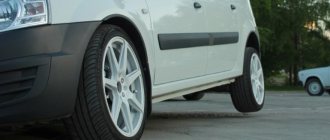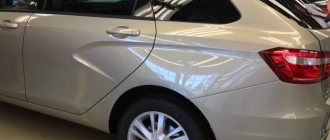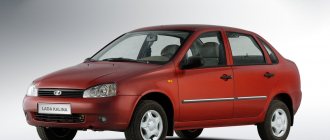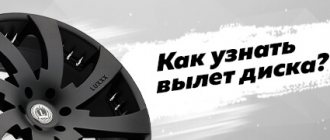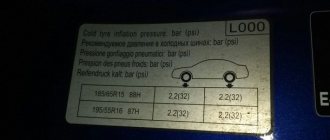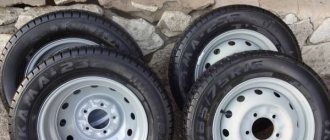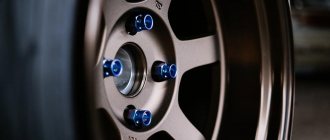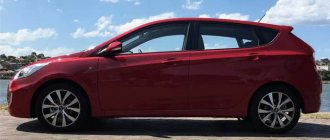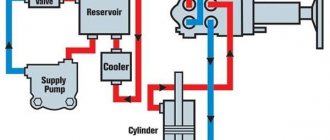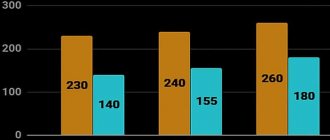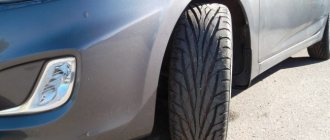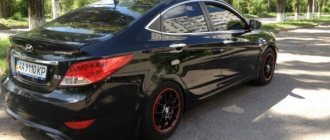For owners and buyers of any car, new or not, a number of questions about its maintenance are always relevant. And those who take the time to be diligent in finding the answers usually reap the bonus of hassle-free ownership, no nasty surprises like unscheduled repairs or deterioration, and saving money. Tires for Hyundai Solaris are in demand all year round, especially during seasonal shoe changes. The correct choice of wheels will have a positive effect on many characteristics of the car, such as handling, driving comfort, safety, chassis service life and some others. And, of course, the appearance, where would we be without it - properly selected rims can make the Solaris more sporty and interesting, giving it a significant amount of individuality.
Hyundai Solaris 2022 with original wheels
Tire and wheel size
The main characteristic when choosing wheels for Solaris is the size. It consists of several numbers - wheel and tire sizes. These characteristics may vary. New cars usually have wheel sizes that vary depending on the modification and configuration. The size of the disk is indicated by two numbers of the form 15 × 5.5, where the first shows the diameter in inches, and the second the width. The width is also measured in inches and its designation may also contain a Latin letter, indicating the design feature of the edge of the edge of the disk. For most modern passenger cars, this is the letter J. This feature provides little useful information when choosing wheels and is usually of interest to specialists. Most often, the following sizes of rims are installed on Solaris:
Another important point is disc ejection. It is marked with the letters ET and shows the distance between the plane that is pressed against the hub and the axis of symmetry of the disk. The offset can be positive, negative or zero. For Hyundai Solaris, the disc offset should remain within 46-52. When choosing wheels you should always pay attention to this parameter. It is allowed to change it by no more than 5-7 mm, relative to the factory one. Significant deviations in the offset value will negatively affect the vehicle’s handling and suspension life. In addition, wheels with an offset different from the specified one may simply not be suitable.
Solaris tire size is another important characteristic when choosing wheels. It is indicated by a marking of the form 185/65 R15, where the number 185 indicates the width of the tire in millimeters, 65 is the percentage ratio of the profile height to the width, the number 15 indicates that such a tire is intended for a rim with a diameter of 15 inches. The letter R indicates that the tire has a radial design; for modern passenger cars, at the moment almost all tires are of this design, so it is not an important parameter.
The most common Solaris tire sizes are 185/65 R15 and 195/55 R16. Such tires, depending on the configuration, can be installed on these vehicles at the factory.
For tuning, you can install larger wheels with a diameter of 17. However, here it is worth paying special attention to both wheels and tires. There are positive examples of installing 17″ wheels, 7.5J wide with ET45 offset. In this case, you can take 215/45 tires. Close to the ideal option with a narrower 6-7J wheel, such wheels practically do not protrude from the arches and look very harmonious. Difficulties when installing 17-diameter wheels can be created by fender liners, which reduce the space in the arches. Oversized wheels can catch on them. Such inconveniences can also occur without wheel arch liners when the steering wheel is turned completely or when driving over large bumps.
Solaris on 17 wheels and low profile tires
When creating this model, Hyundai engineers paid great attention to fuel consumption. In their opinion, this characteristic is more important for a city car than a sporty appearance and outstanding handling at high speeds. They chose wheels of small diameter and small width for a reason. They have a low weight and low rolling resistance, which has a positive effect on dynamics and efficiency. Installing wheels with a larger mass will have the opposite effect, to a greater extent this applies to Solaris with a 1.4 liter engine, which do not suffer from excess power.
What is the tire pressure for Hyundai Solaris?
Each tire manufacturer determines the pressure for tires individually, based on their technical indicators and characteristics. Exact data is always indicated in the vehicle's operating manual.
| Name | Atmospheres (Bar) |
| Front (summer) | 2.1 |
| Rear (summer) | 1.9 |
| Front when fully loaded | 2.4 |
| Rear at full load | 2.8 |
| Winter (front/rear) | 2.2 / 2.1 |
Wheel bolt pattern
The bolt pattern of the Hyundai Solaris is another important point when choosing wheels. This parameter is sometimes also called drilling. It consists of two numbers of the form X*X and is denoted by the abbreviation PCD in disc labeling. Shows the number of bolts on which the wheel is attached and the diameter of the circle on which they are located. On passenger cars, four to six studs are typically used.
For Solaris, the PCD value is 4*100, which means that the wheel is mounted on four bolts located on a circle with a diameter of 100 mm. The wheels of the Kia Rio, a classmate from another Korean manufacturer, have the same bolt pattern. The hub hole in the disk has a diameter of 54.1 mm, the thread on the studs is M12*1.50. This type of thread is widespread and is found on many cars. Its value should help when choosing flare nuts for securing wheels. The hub hole may be larger than specified.
Parameters of standard nuts
Wheels for Hyundai Solaris cars produced between 2011 and 2022 were fastened with standard M12x1.5 nuts. The thread diameter of the nuts is 12 mm, and the thread pitch is 1.5 mm. Tightening torque – 88-107 Nm. Material – steel coated with chrome and zinc.
The original stamped wheels have open-type cone nuts 34 mm long. For non-original casting, it is recommended to install nuts 34-40 mm long, since cast wheels are thicker than stamped ones. For this reason, it is better not to place nuts from stamped wheels on alloy wheels - the engagement of the threaded connection will be insufficient for their reliable fastening.
Tire quality
In addition to the size of the rims, bolt pattern, type of tires and other things, there are still important points that you should pay attention to when choosing wheels. This is the quality of rubber for Hyundai Solaris. Of course, it is more difficult to determine it by appearance, but you can use information from manufacturers and benefit from the experience of other motorists. In general, tire quality will affect the following indicators:
- Braking efficiency;
- Controllability;
- Comfort when driving;
- The durability of the tires themselves.
At the factory, new cars are equipped with Kumho Solus or Hankook Optima tires. This is an inexpensive Korean-made tire that nevertheless meets modern requirements for road grip, durability and noise level. Such wheels can be safely installed after the factory set has worn out; their characteristics are sufficient for comfortable movement in city conditions. They have good ability to drain water when driving in wet weather, and also have good speed and weight indexes with a reserve for this car. On the highway, under normal conditions, in compliance with the permitted speed limits, they also do not cause any complaints.
Fans of dynamic driving with sharp accelerations and the same pressure on the brake pedal in difficult road situations may need wider rubber capabilities and improved performance. They should consider options like the Hankook Tire Optimo K406 88H (up to 210 km/h), Continental ContiPremiumContact 2, Dunlop SP Sport FastResponse 88V (up to 240 km/h) or something like that. These tires are significantly more expensive, but are much better suited for high speed loads and braking. Naturally, the choice of good wheels for Solaris is not limited to these brands; in this price segment there are a large number of excellent offers from various world-famous manufacturers, including Nokian, Bridgestone, Yokohama, Pirelli and others.
There are also less expensive options to refit your car, and they are quite suitable for those drivers whose priorities are not speed performance, but price and normal overall performance are more important. Examples of such tires include Dunlop SP Touring T1, Viatti Strada Assimetrico V-130, Cordiant Sport W1 for summer, Viatti Brina V-521, Cordiant Polar 2, Dunlop SP Winter Sport 400 and others for winter.
How the pressure sensor works, how to turn it off
Starting from the second generation, Hyundai Solaris is equipped with electronic tire pressure sensors. The first generation has mechanical sensors. Due to insufficient efficiency and information content, the latter were replaced by modern ones.
The main task of the digital gadget is to monitor changes in air pressure in the tire and transmit data online to the electronic control unit. The latter compares the indicators with the programmed ones and informs the driver about a possible malfunction. Most often, this is a sound signal combined with light flickering.
Principle of operation
- A pressure measuring sensor is installed on the inside of the tire. This must be done with the wheel lowered.
- After activation, the controller measures the pressure every 3 seconds and sends the data to the ECU. Bluetooth technology is used as a means of communication.
- The electronic control unit analyzes the obtained indicators for each of the wheels and compares them with the specified parameters.
- The end result can be duplicated on a smartphone if a special application is installed on the latter.
How to disable pressure sensors
There is no such thing as deactivating a sensor for the reason that it is impossible, since the absence of equipment must be registered at the system level. In case of unauthorized deactivation of the controller, “Error” is displayed on the dashboard.
Some car owners practice physically dismantling controllers in a service station. Do not try to do this on your own, as unprofessional intervention does not guarantee full functionality of the electronic control unit.
Sensor sensitivity
- Sudden surges in pressure due to falling into a hole or road bump;
- Critical low/high pressure;
- Installation of rubber tires that are larger or smaller than the recommended standards;
- Installing a damaged tire;
- Uneven distribution of load on the axle, passengers in the vehicle interior;
- Systematic operation of the controller during lifting and lowering of the machine;
- Metal chains are installed on rubber tires.
Answers (2)
16-inch wheels are installed from the factory on Solaris in the maximum configuration. These wheels look very cool and harmonious.
Factory tire size: 195 / 55 / R16. I recommend setting these parameters - this is the ideal size:
Disc: bolt pattern - 4X100, width - 6J, 6.5J permissible, offset - ET48-52, slight deviation permissible, hub diameter - CO 54.1 mm, take the disc no smaller than this hole, otherwise it simply won’t fit, if it is larger, then you can solve problem with centering rings.
You should not install tires measuring 205/55 R16 - the Solaris will look awkward on them, and these tires will extend beyond the arches, thereby sand and dirt will dirty the car faster.
The Russians saw the first Solaris, assembled in St. Petersburg by Hyundai Motor, a subsidiary of Hyundai Motor Company, in 2011. And I must say, it became a good competitor for the then popular Renault Logan and VW Polo.
The Hyundai Getz was no less in demand, but it was discontinued so as not to create competition between models of the same brand.
As soon as the new car went on sale, wheels for the Hyundai Solaris (meaning the size) immediately became scarce due to the sharp rise in demand. What was the reason for this, and what range of tires and wheels are offered for this car today? You will learn about this and much more from this article.
General background information
Ranges of possible values for tires and wheels Hyundai Solaris 2011.
Tires
| Diameter | 14″–17″ |
| Width (mm) | 175–205 |
| Profile (%) | 45–70 |
| The smallest size | 175/70 R14 |
| The biggest size | 205/45 R17 |
Wheel disks
| Diameter | 14″–17″ |
| Width (inches) | 5.5–6.5 |
| Reach (mm) | 43–52 |
| Drills | 4×100 |
Expert advice
When choosing tires for a car, you must first follow the manufacturer's instructions. Ask yourself a few questions.
- On what roads will the car be primarily used?
- Do you need increased cross-country ability?
- How much of the route will be city roads and how much will be highways?
- Will the vehicle carry heavy loads?
Which tires to choose for the summer
In the summer, the overwhelming majority of Hyundai Solaris drive on 185/65 R15 tires. Therefore, when choosing wheels on the eve of the summer season, we will take this size as a basis and, as always, turn to the results of tests conducted by some authoritative magazine or club specializing in such issues.
Summer Tire Marathon 2019
In our case, it will be the German auto club ADAC, which held the 2022 marathon for tires of the above size. Tires from 16 manufacturers took part in the test.
Its results turned out to be quite unexpected in the sense that some premium brands, which previously always occupied the first lines of the hit parade, moved down, giving way to tires from the medium sector.
Four rating categories were used: good, satisfactory, unsatisfactory and mediocre. Only two participants received the highest rating of “good”; all the rest received “satisfactory”. Fortunately, there were no lower ratings.
Let's look at the breakdown of participants based on the results of the auto review:
Bridgestone Turanza T005 (1st place)
The main surprise for the organizers of the auto review was Bridgestone, which took first place, since the summer tire of this brand rarely received prizes at such events.
But this time Turanza T005, which debuted the year before, 2022, broke all records, becoming the best on both dry and wet roads. And this is more than pleasant, considering that the previous model of this brand (Turanza T001) 3 years ago could only take 12th place.
Vredestein Sportrac 5 (2nd place)
The brainchild of the Russian-Dutch concern Vredestein, which today owns two Russian tire factories - Voronezh and Kirov, was able to approach the results of the Japanese Tyuranza.
True, the Sportrac 5 tire, which participated in testing, is produced in the Netherlands. It was only slightly inferior to the Bridge, and together with it was awarded a “good” rating, captivating the judges with its resistance to wear and excellent grip on wet roads.
Michelin CrossClimate+ (3 m)
Since all-season tires are still more summer than winter tires, they were also allowed to compete. These include the French-made Michelin CrossClimate+, which took an honorable third place in this race.
Recommendations for disc care
- Check the geometry and wheel balancing on a special diagnostic stand. If deviations are detected, restore the integrity of the structure at a service station. It is impossible to “reanimate” the disk on your own due to the lack of necessary equipment;
- Immediately contact a service station for preventive maintenance if you find cracks or dents on the rim;
- Avoid getting into potholes, especially at high and medium speeds. The disk will be deformed, the seal will be broken, regardless of the material of manufacture;
- Monitor the tire pressure; it should not differ from that recommended by the manufacturer. If there is a deviation, pump it up yourself, contact the service station;
- Observe the transition to summer and winter modes. In summer, the tire pressure is 0.15 atm higher, in winter it is lower by the same amount. The parameters are specified in the vehicle operating instructions;
- Tighten the rim nuts with a torque wrench. Excessive tightening contributes to the breakage of the studs, weak - to the unscrewing of the wheel and a collision on the road.
In sunny weather, cast aluminum wheels are least susceptible to external damage. But in slush, ice, when the road is strewn with various chemicals, the rim is susceptible to corrosion. This provokes paint peeling and destruction of the molecular composition.
Wash your wheels as they get dirty. Since it is unlikely that you can clean it properly with a rag, use high-pressure compressors. Equipment of this class is available at many service stations, workshops, and service centers.
Systematic polishing allows you to get rid of scratches and burrs. First clean the wheel from dirt, dry it thoroughly, and then treat it with a chemical. Wipe several times with a microfiber cloth.
Store wheels in a hanging position, do not stack them on top of each other. Clean off any dirt, dry, and wrap in cellophane. Some motorists practice applying an aerosol to the surface before preservation. However, this is a purely personal decision of the owner.
The average service life of original wheels is 150 – 180 thousand km. Subject to a moderate driving style, the replacement interval will increase by a third. The service life of tires is half as long as disks.
Decoding disk markings
For example, R17 4×100 5.5J ET46
- PCD (Pitch Circle Diameter) diameter of the center circle of the mounting holes: 87 mm;
- Disk radius at 17;
- Drilling: number of holes 4;
- Fastening type: M10 – stud diameter;
- Thread size (pitch): 1.25;
- Center hole diameter: 57 mm;
- Pressure (front / rear): 2.0 / 2.1 bar.
The PCD value is calculated by the distance between the centers of opposite holes. We measure with a ruler, but do not dismantle the wheel. For four bolt construction, the PCD corresponds to the actual distance.
Rim offset is indicated by “ET”, the unit of measurement is millimeters. This is the distance between the point of contact between the disc and the hub and the middle of the rim width.
In different countries the designation is different: DEPORT, OFFSET. The offset is positive if the plane does not extend beyond the point of contact, otherwise the offset is negative.
The further the rim is from the body, the more the offset tends to zero.
- D is the diameter of the central hole, measured in millimeters.
- J, H and subsequent alphabetical symbols indicate the markings of the humps on the rim flange. Symmetrical, asymmetrical and combined.
- The “Hump” is a protrusion on the rim for a tubeless tire. When moving, the “rails” hold the tire beads, preventing depressurization.
Numerical characters indicate the release date, month, year.
- TUV is an abbreviation for the regulatory authority for compliance with quality standards.
Maximum wheel load: the unit of measurement depends on the country of manufacture of the rubber and rim.
The best tire manufacturers for Hyundai Solaris
This car is a budget vehicle. And not every driver will risk purchasing tires for their “iron horse” from a renowned manufacturer. In this regard, below is a rating of the most popular tire brands for Hyundai Solaris based on real reviews from owners:
- Depending on the cost and configuration, the car owner receives Hankook Optimo K715, ME02 K424, Ventus ME01 K114 or Prime 3 K125 tires in the showroom. In addition, Toyo Tranpath MPZ, Proxes CF2, T1 Sport, T1-R or Nano Energy 3 tires are in high demand among buyers.
- The best value for money are the tires on Solaris from Falken, which is a budget division of the world famous Japanese brand Bridgestone. And the ZIEX ZE-512 model fits perfectly with standard Solaris wheels.
You may be interested in this About plastic and rubber linings on wheel arches
Winter tires for Solaris
- Among the owners of the Korean brand, BF Goodrich tires in the G-Grip modification from a joint American and Russian production company are very popular, which have an acceptable cost and a high level of reliability among competitors.
- For those motorists who are ready to incur significant expenses for ideal quality, the world famous brand Goodyear is ready to offer an all-season modification, Vector 4Seasons Gen-1. Despite the relatively high cost of the products, by installing such wheels on Solaris, the driver has the opportunity to save significant money on tire fitting over the next 3...4 years.
- Owners of Solaris should pay attention to time-tested Chinese manufacturers in the Russian Federation, since individual companies in the Celestial Empire have long stopped producing low-quality products, stocking up on advanced Western technologies and equipment.
On a note!
Among the wide range of products, drivers can choose models such as Triangle 978 or 918, Tigar Sigura or High Performance, and they will also be satisfied with the Nexen N'Blue HD Plus, NBlue HD, N8000 or N'Fera SU1 tires, as these brands have long been adapted for wide use in central Russia.
Winter tires Triangle R16
The last rational decision when choosing tires for the Hyundai Solaris would be increased attention to reputable domestic tire factories.
This is due to two dominant factors. Firstly, most factories in the Russian Federation have long been adapted to advanced European, Asian or American technologies, as they operate on imported equipment. And some of them have even concluded international bilateral agreements, working in the country under franchises from well-known global brands.
Secondly, Russian manufacturers focused on the domestic sales market have a low cost of their products, since the costs do not include any items for transporting products from abroad and their customs clearance.
Among domestic brands, Solaris owners often choose the Matador MP44 Elite 3 or MP47 Hectorra 3 models, which belong to the famous German manufacturer Continental, but are produced in Kaluga.
Important!
The main condition for ensuring quality for all the brands listed above is the originality of all products, since purchasing cheap replicas cannot guarantee operational reliability and a brand guarantee.
A little about the car
Eight years is a sufficient period for car owners to comprehensively study and evaluate any car. And if the decision is made to release the next generation, it means that everything went as it should, sales are going well and all that remains is to take into account the opinions of the consumer, making the car even better. This is exactly what happened with the Hyundai Solaris.
Since this is a small class B city car, it was equipped with only two options for small engines - 1.4 and 1.6 liters. The first option, with a power of only 107 hp. was not in great demand, and therefore the number of its sales was significantly lower.
However, to work with a more powerful 1.6l engine, the automatic transmission was clearly not enough, which was the reason for some modifications to the model.
In particular, Hyundai has modernized the rear suspension several times, which has helped improve the car's stability when driving and eliminate sway on poor-quality road surfaces.
In the basic configuration, Solaris was equipped only with a 1.4 liter engine with a manual transmission, steel wheels (wheel diameter 14 inches) and only one airbag. No other security systems, including anti-lock ones, were installed on them.
Solaris 2011 (1st generation)
Three years later (in 2014), the car was restyled, and in the middle of the year the updated version was already on sale. The changes affected the gearbox, which added the number of steps, an electrical part, a steering wheel that became conveniently adjustable for reach, and new body painting options appeared.
2011-2014
The first generation Solaris are a sedan and a five-door hatchback with an I4 engine.
5.5Jx14 ET43 – for these discs the offset range ranges from 35 to 45 mm. This is the factory size for first generation cars.
Helpful information
Settings
Connect with us
About the site
Wheel Size is a reference book of factory tire sizes and wheel parameters. We strive to provide all the information you need about the standard wheel sizes for your car and replacement options.
Please keep in mind that although much of this information is taken from vehicle manufacturers' websites, this catalog is for informational purposes only and does not guarantee that the dimensions offered will fit your vehicle.
Almost every Russian car enthusiast is familiar with the Korean brand Hyundai, which has gained popularity in the country since the end of the last century. Hundreds of different models of all known classes of passenger vehicles rolled off the assembly lines of numerous factories of this auto giant. The most famous model of the brand has always been the Hyundai Accent. And the equally famous Solaris, whose production started in 2011, became even more popular as one of the modifications of small city cars, adapted specifically for operation in the harsh climate of the Russian Federation.
